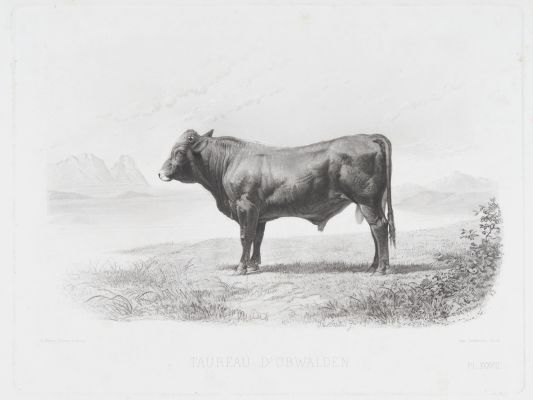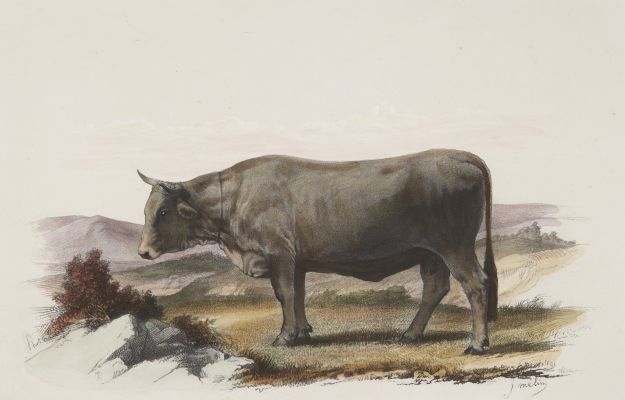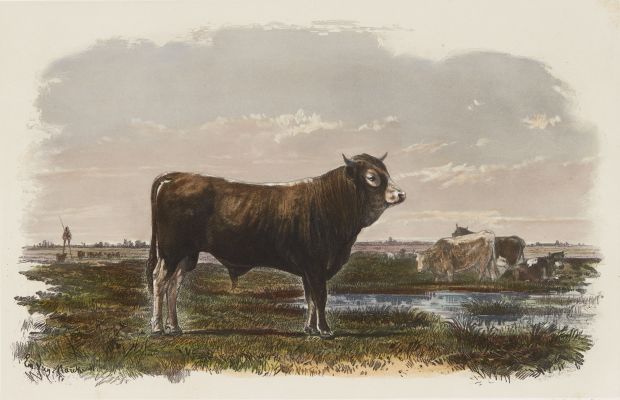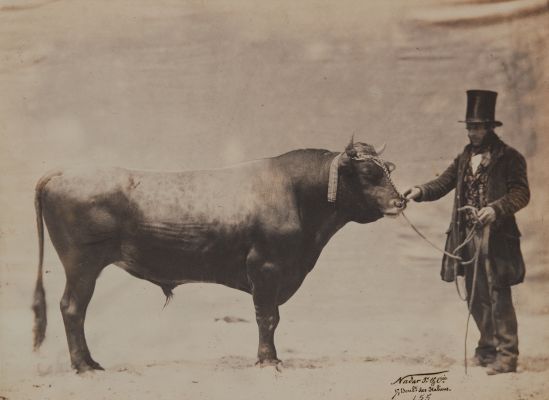
Title
Vache HongroiseArtist
Tournachon, Adrien (French, b.1820)Date
1860 caProcess
Glymmatogravure (hand-colored)Atelier
BaudranImage Size
23 x 33.7 cmSheet Size
33.5 x 46.5 cm
Auguste Baudran was a French engraver who translated art into intaglio plates for the Gazette des Beaux Arts. Baudran, at a meeting of la Société des Sciences Naturelles et Médicales de Seine-et-Oise, February, 1864, outlined the various processes he employed starting in 1855. “…he conceived transferring drawing onto steel that he called glymmatographie, produced as follows: drawing, done on white paper, in black crayon or pencil, is applied to the plate, which has previously received a slight oily coat, and it leaves its impression by the action of the press; a coat of a certain substance is then applied to the impression, and covered with a gelatin plate applied to the polished side; it is run through the press again, and the removed gelatin receives all parts of the drawing in black, while the plate only retains the blank parts. There remains only to plunge this plate into an ordinary bath of dilute nitric acid, so that it is etched. Mr. Baudran showed a proof of a cow, from the collection of the Ministry of Agriculture and Commerce…Mr. Baudran also placed before the eyes of members a series of portraits produced by another process – and having quite the look of engravings; this process he calls glymmalographique engraving consists of replacing drawings by the above process with hand engraving, made by metal tip or pen on plain paper or on gelatin. Mr. Baudran then moved on to his gravure etching processes. After paying tribute to Messieurs Niepce for the discovery of important properties of bitumen of Judea, he pointed out the inadequacy of this bitumen coating, and stated that he had made changes to the preparation, so that he could use concentrated nitric acid up to 40 [degrees Baumé] and thus produce deep cuts allowing a large print run. He passed round some of the plates started by the gravure process, and completed by glymmatographie, giving a mixed process of lithography-engraving. Mr. Baudran also worked heliographic engraving in intaglio; he gave some details about ordinary machines for engraving hatching and described the machine he had invented, and whose use is so fast, the substance that covers the plate does not have time to dry. He gives it the name heliographic machine because of its characteristic of raising the burin on the blank parts, using a special device. He passed round a series of untouched portraits, produced by this machine, as well as views of Versailles and the Trianon, a plate of which was examined under the magnifying glass, then another series of portraits from the collection of Nadar contemporaries for which all heliographic processes were used. The last procedure was the one he and De La Blanchère used to make the Heliogravures (photogravures) from Nadar portraits during the mid-eighteen sixties. The plates have a pronounced grain and appear to be heavily retouched. Also the Nadar signature is clearly evident on the plates and so they must have used copy negatives or reversed positives for their plates. [1]
Reproduced / Exhibited
Hanson, David A. Checklist of Photomechanical Processes and Printing, 1825-1910. , 2017. p. 15.
References
[1] Hanson, David A. Checklist of Photomechanical Processes and Printing, 1825-1910. , 2017. p. 15.











